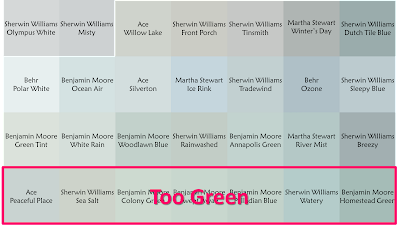What I didn't realize is that painting pretty much every single room in the house is a BIG project! And one that I didn't have a lot of skill to prepare me for. Don't get me wrong, I've painted many a room in my life. But being frank, I've never really liked many of the colors I've chosen over the years.
I've never educated myself much in interior design, just put things together by trial and error. This time around, with the paint, I'm really not interested in trial and error. I want to get it right the first time!
The first thing I did was google "how to pick paint colors". There weren't many websites on the subject, but I did see a number of YouTube videos (How to Choose a Paint Color, Choosing Paint Colors Like a Professional I and II, and How to Choose Paint Colors). I watched about half a dozen videos on color theory and choosing interior paint colors and came away with the following:
- There's a measurement called the Light Reflectance Value (LRV) that expresses the percentage of light reflected from a surface.
 |
| see more on color theory ay Color Budz |
- This is important, because LRVs of less than 50 can make a room look dark. LRVs above 50 make a room look lighter. We're choosing LRVs above 40 for our house; the rooms are on the small side and we want them to feel as large, light, and airy as possible
- For a color to be easily distinguished from another (e.g. white trim paint), the difference in LRV should be greater than 20. Many white paints have LRVs in the 80's, so in our house, we shouldn't choose paints with LRVs greater than in the 60's if we want them to look significantly different than the trim, which we do.
- The color wheel means something! Choosing colors from opposite sides of the color wheel can help them balance out. Our house is FULL of orange-toned wood. We're talking cabinets, floors, walls, trim, blinds, light fixtures, carpet...FULL! To add some contrast to all these orange tones, it would be a good idea for us to use blue tones on the walls.
 |
| A very nice color wheel put together by Cornell |
- Using colors with grey in them was another big designer recommendation. They were especially fond of colors that couldn't be described with just one word. So "blue" should be avoided, but "bluey green gray" is something I should strive for. The super bright colors (no grey) can apparently look childish or garish.
So by this point I'd narrowed it down to bluey/green/grey tones with LRV between 40 and 70. But that still left a LOT of colors!!!
To further hone the selection, I sat down with my husband and browsed Houzz and Pinterest for inspiration. We decided to start with the living room, as it's where we spend a lot of time.
 |
| pinned from The Inspired Room |
 |
| pinned from Better Homes and Gardens |
 |
| pinned from Better Homes and Gardens |
OK, so now we're looking for a bluey-green-grey, kind of in the turquoise family.
I went to Home Depot, Sherwin Williams, and the local Benjamin Moore carrier and grabbed a bunch of different paint swatches. I taped them all to the wall, and sat back to have a look.
 |
| Blue Green Gray Paint Swatches |
Some were too dark.
Some were too gray.
Some were too blue.
Some were too green.
But a few seemed just right!
I waited a few hours for the light to change. Not only do we get nice indirect morning light, we also get direct afternoon light, sunset reflected off the lake, and artificial light. We wanted to choose a color that would be nice in as many of those as possible.
That night, a few more were removed. And another few the next morning.
Until finally I was left with one: Rainwashed by Sherwin Williams. It's a greyed down turqoise with an LRV of 60 and RGB of R-194, G-205, B-198. Don't be fooled by the online swatch - it's a little different in person!
Stay tuned for the when I paint the living room and the half-bath.
You might also be interested in these posts:
Living Room Updates
Half Bath Reveal
Kitchen Updates
















































